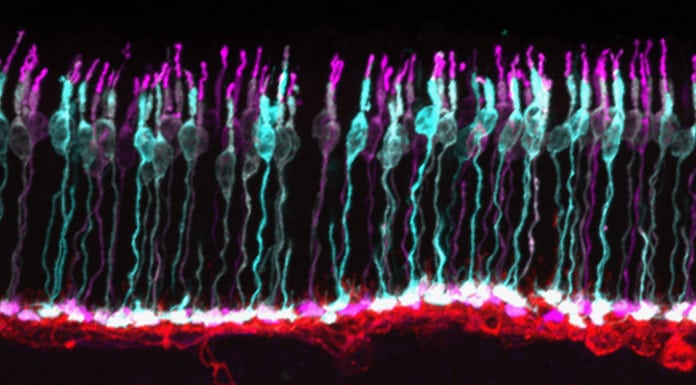The Institute of Molecular and Clinical Ophthalmology Basel (IOB) bridges basic and clinical science to advance the understanding of eye diseases and to develop new therapies for vision loss.
Globally, the prevalence of eye diseases continues to rise. Most are currently untreatable. In ageing societies, disorders such as macular degeneration or glaucoma are a leading cause of disability and loss of independent lifestyle. Blindness is what patients fear most. A 2016 survey published in JAMA Ophthalmology1 showed that nearly 50% of respondents ranked vision loss as their worst conceivable health impairment, outranking loss of memory, limbs, speech and hearing. Worldwide, and especially in Asia, myopia (short-sightedness) is rapidly increasing. In some regions, up to 90% of teenagers are affected, compared with
10-20% in the Chinese population 60 years ago. The problem with myopia is not the need to wear glasses, but frequent loss of vision via resulting complications, such as retinal detachment, glaucoma or macular degeneration. However, in ophthalmology, innovation has been slow for many years.
Led by two world-renowned experts in ophthalmic research and ophthalmology, Botond Roska and Hendrik Scholl, the Institute of Molecular and Clinical Ophthalmology Basel (IOB), Switzerland, addresses this challenge as a highly collaborative and interdisciplinary institute. Roska is a pioneer in fundamental research on the retina and the processing of optic signals in the brain. Scholl is Chairman of the Department of Ophthalmology at the University of Basel and Head of the Eye Clinic at the University Hospital Basel. He specialises in medical and surgical management of retinal diseases, especially inherited degenerative diseases.
Bridging basic and clinical science
As one of the first of its kind worldwide, IOB bridges basic and clinical science for eye diseases within one organisation. “Ophthalmology faces a major gap between basic researchers and clinicians,” Roska said. “Basic researchers rarely understand the unmet medical need, because they do not see patients. Clinicians are often not aware of the latest advances in molecular research. For the development of new therapies, a deep understanding of the retina, eye disease and translation to clinical application should be combined. Collaboration across disciplines and between basic scientists and clinicians is indispensable. At IOB, our basic researchers and clinicians work hand in hand daily to improve the understanding of the functions of the eye, and of the mechanisms involved in eye disease. Together, we develop new treatments which change the practice of ophthalmology, based on the genetic, structural and functional understanding of the cell types and their interactions within the human eye.”
Roska and Scholl have merged their existing research groups in the new organisation. They have admired each other’s work for many years before the opportunity finally emerged to establish this new research institute. It promises hope to millions of patients worldwide suffering from currently incurable forms of vision impairment or vision loss.
Scholl said: “Our goal is to change the field of ophthalmic therapy. We are working to accelerate the conversion of basic research into innovative treatments. Currently, we have limited treatment options for patients with blinding eye diseases.
“We are therefore grateful for this unique opportunity of establishing a truly translational institute to significantly advance treatment opportunities. Today, ground-breaking medical innovations are not just made in a lab, but happen at the interface of academia, healthcare
and industry. IOB is a successful example of a public-private partnership, constituted as a foundation to grant full academic freedom to our scientists. The substantial long-term financial commitment of our founders – the University of Basel, University Hospital Basel and Novartis – and of the Canton of Basel-Stadt gives us freedom to build a platform combining world-class academia, proximity to patients and a strong commitment to innovation. We will establish 10 endowed professorships and 125 additional positions for scientists by the year 2024.”
Retinas on a dish
One of the latest successes to accelerate eye research are ‘retinas in a dish’. With stem cell technology, researchers in the group of Botond Roska can transform patients’ skin samples into in vitro retinas with the donor’s genetic markers.
“We use them to test new therapeutic strategies based on the cellular circuitry of the retina. A better understanding of genetic components to retinal disease will allow us to compile an atlas of genetic eye diseases. Ultimately we want to test the efficacy of gene therapies”, Roska explained.
Scholl is developing methods to better measure and quantify vision. He is also working to advance our understanding of Stargardt Disease, an inherited juvenile form of macular degeneration. It is very similar to the age-related form of the disease, the most common cause of blindness in the developed world. In addition, he studies retinitis pigmentosa, a hereditary eye disease leading to vision loss – and, in many cases, complete blindness with no light perception – in nearly 1.5 million people worldwide.
“Both diseases are currently incurable. We want to tackle them with gene therapy. I am confident that our work will bring novel therapies to countless patients suffering from vision impairment or loss,” he concluded.
References
- Scott AW, Bressler NM, Ffolkes S, Wittenborn JS & Jorkasky J (2016) Public Attitudes About Eye and Vision Health. JAMA Ophthalmol. 134: 1111–1118.
Current IOB research priorities:
- Development of gene therapy for macular degeneration (Stargardt Disease);
- Optogenetic approaches to generate light-sensitivity in the retina of blind patients suffering from retinitis pigmentosa;
- Development of human retinal organoids as in-vitro testing models for glaucoma research;
- Growth regulation of the eye bulb to address myopia; and
- Identification of currently unknown disorders of movement detection.
Institute of Molecular and Clinical Ophthalmology Basel (IOB)
+41 61 265 86 51
info@iob.ch
Tweet @IOB_ch







